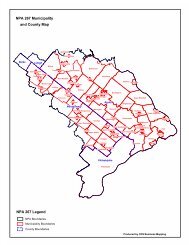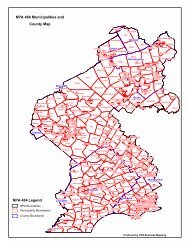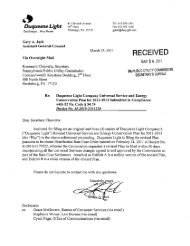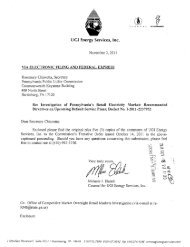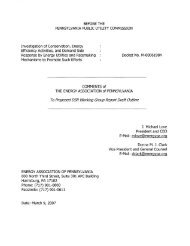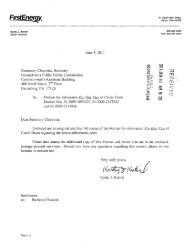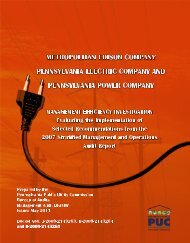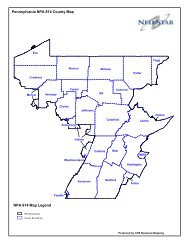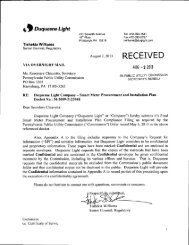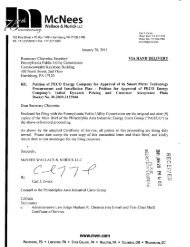2010 Report - Pennsylvania Public Utility Commission
2010 Report - Pennsylvania Public Utility Commission
2010 Report - Pennsylvania Public Utility Commission
Create successful ePaper yourself
Turn your PDF publications into a flip-book with our unique Google optimized e-Paper software.
system and to make recommendations for their remedy. Highlights of this recent assessment aresummarized below (pages 1-6, emphasis added):• Reduced economic activity and higher adoption of demand side management programshave led to decreased projected peak demand for electricity and, as a result, higherreserve margins throughout North America for much of the 10-year period. The increasein demand side management contributes to 20 percent of the total reduction in summerpeak demand for the 2017 forecast when compared to last year’s forecast, whileeconomic recession effects contribute 80 percent.• Over the next 10 years, 260,000 MW of new renewable nameplate capacity (biomass,geothermal, hydro, solar and wind) is projected, 96 percent of which is wind (229,000MW) and solar (20,000 MW). Wind power is projected to account for 18 percent of thetotal resource mix by 2018, but accounts for only 3 percent (or 38,000 MW) of the peakresource mix. Industry, policymakers and regulators have significant work ahead ofthem to ensure that sufficient transmission is sited and built to enable the integrationof projected renewable resources.• By 2011, natural gas is projected to overtake coal as the dominant fuel source for peakcapacity generation in North America. By 2018, natural gas is projected to account for32 percent of the on-peak resource mix. The projected growing reliance on natural gasincreases the potential for adverse reliability impacts due to fuel supply and storageand delivery infrastructure adequacy issues.• More than 11,000 miles, or 35 percent, of transmission (200 kV and above) proposed andprojected in this report must be developed on time to ensure reliability over the next fiveyears. Ranked as the No. 1 emerging issue in terms of likelihood and consequence,transmission siting remains a significant obstacle to meeting this goal. State andprovincial siting and permitting processes must be expedited to allow for thedevelopment of needed resources and ensure reliability.• Over the coming 10 years, the North American electric industry will face a number ofsignificant emerging reliability issues. The confluence of these issues will drive atransformational change for the industry, potentially resulting in a dramatically differentresource mix, a new global market for emissions trading, a new model for customerinteraction with their utility, and a new risk framework built to address growing cybersecurity concerns.NERC has also identified five emerging issues which could have a significant impact on reliability(pages 51-66):• Economic Recession. The economic recession has had an indelible impact on theelectric power industry. While there is currently substantial uncertainty on the time, rateand breadth of an economic recovery in the coming years, it is certain that its eventualarrival may present risks and challenges to the bulk power system on several levels: (1)the recession has caused significant impacts in demand forecasts; (2) economicdifficulties that drive new business opportunities and incent new resource programs maydrive steep increases in these programs (and accompanying reliance upon them) butvigilance will be required to ensure they are available when needed for reliability; (3) aneconomic recovery will occur (eventually), but it is uncertain when it will happen and62<strong>Pennsylvania</strong> <strong>Public</strong> <strong>Utility</strong> <strong>Commission</strong>



